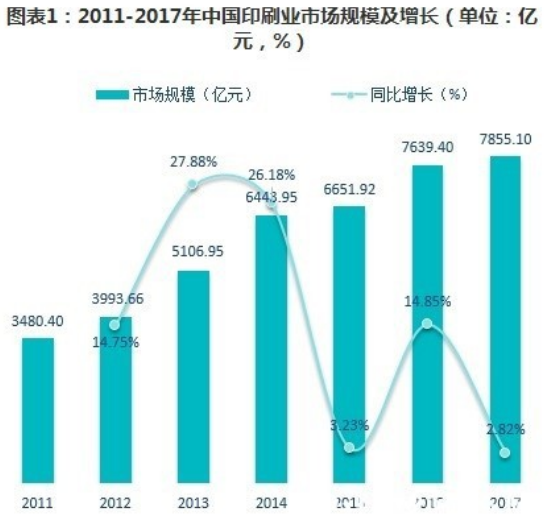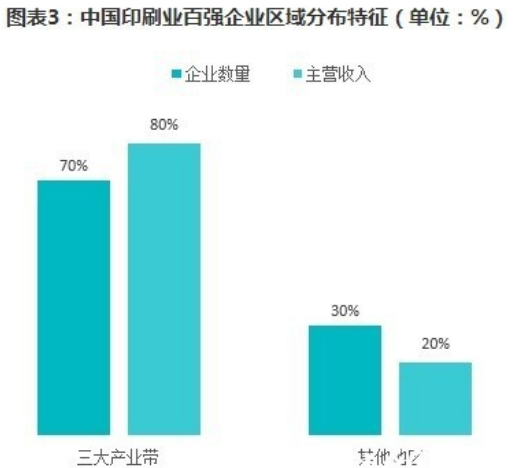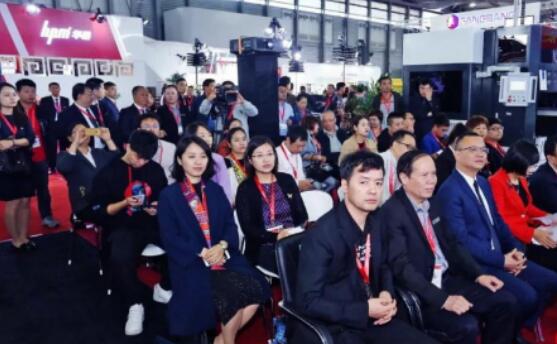China's printing industry has a long history and many internal subdivisions, which can be divided into publishing printing, packaging printing and other printing, etc., and its products are used in various fields of national economic life. Thanks to the rigid demand of the national economy, cultural market and the integrated development of global integration, China's printing industry has made great progress, the market size has been growing, and gradually formed an industrial economic system with knowledge and information as the main content and can affect international competitiveness.
At present, printing has become one of the important components of the national economy. Data show that from 2011 to 2017, China's printing industry market grew rapidly, with a growth rate of more than 10% in many years. In 2017, the market size of China's printing industry was 785.510 billion yuan, an increase of 2.82%.

Market concentration is low
As of the end of 2017, there were 5,491 enterprises in China's printing industry, an increase of 228 over the previous year, an increase of 4.33%, the market competition is more fierce, and the lack of large-scale leading enterprises, the revenue of listed companies relative to the huge market total volume is still small.

Moreover, China's printing enterprises have their own characteristics in some segments, such as newspaper printing, cigarette label printing, label printing, bill printing, etc., general commercial printing and packaging printing enterprises are also scattered, and there are a large number of small and medium-sized printing enterprises, with high product homogeneity, which intensifies market competition.
In the face of the low concentration of the status quo, the State Administration of Press, Publication, Radio, Film and Television issued the "printing industry" 13th Five-Year "period development Plan" clearly stated that during the "13th Five-Year" period, the national printing demonstration enterprises, small and medium-sized characteristics of printing enterprises to further enhance the radiation leading ability, industrial concentration continues to improve. By the end of the 13th Five-Year Plan period, the output value of key printing enterprises above designated size will account for more than 60% of the total output value of printing, and a number of large printing enterprise groups with international competitiveness will be cultivated.
The development of regionalization is uneven
From the perspective of market layout, printing industry enterprises show obvious regional characteristics, Guangdong as the center of the Pearl River Delta, Shanghai and Jiangsu and Zhejiang as the center of the Yangtze River Delta and Beijing-Tianjin as the center of the Bohai Sea three regions have formed three major industrial belts. The above three regions are also more dynamic regions in China's economy, and the printing and publishing, food and beverage, daily chemical and other industries are more developed. In addition, as a gathering place for electronics and light industry, the southern Fujian region and Jiaodong Peninsula also gather more packaging and printing enterprises.
From the perspective of the distribution of the top 100 enterprises, the Pearl River Delta, the Yangtze River Delta, and the three industrial belts around the Bohai Sea gather 70% of the enterprises, and the main income of these enterprises accounts for 80%, and the imbalance of regional development can be seen.

In this regard, the "Plan" pointed out that during the "13th Five-Year Plan" period, the coordinated development of various regions is required, and the entire industry has shown strong resilience. The effect of industrial clusters in the Pearl River Delta region has become more prominent, the comparative advantage of the Yangtze River Delta region in high-end processing services to foreign countries has been further strengthened, the coordinated development of the Beijing-Tianjin-Hebei region has accelerated, and the central and western regions have continued to increase the level of capacity transfer.
The industry has made remarkable technological progress
To realize the initial transformation from a printing power to a printing power is one of the main goals of the 13th Five-Year Plan, and it is imperative to accelerate the development of printing technology in the future. In fact, since 1998, the technical level of China's printing industry has been greatly improved, and the number of related patent applications has fluctuated, reaching a peak of 12,417 in 2017. Under the guidance of the above goals, new patents will continue to emerge, and the number of applications is expected to reach a new high.

Packaging printing and green printing are developing rapidly
As the largest branch of the printing industry, packaging and printing widely serves various industries in the national economy and residents' lives, such as food and beverage, daily chemicals, electronic communications, tobacco, medicine, clothing and other fields, and a wide range of services, and its development is closely related to the development of its downstream service fields. During the "Twelfth Five-Year Plan" period, with the rapid development of China's food industry, medicine, electronic information, e-commerce, logistics and other industries, China's packaging and printing industry has developed rapidly. In addition, due to the relatively small scale of investment in the packaging and printing industry, the ability to absorb labor is strong, and the degree of environmental damage is low, which is favored by many local governments, and policy preferences and support have promoted the rapid development of the industry.
In addition to the rapid development of packaging printing, green printing has also become one of the important themes of the development of the industry. Policies and markets require printing technology to be more environmentally friendly, packaging consumables are constantly environmentally friendly and economical, printed matter is easy to recycle after waste, can be naturally degraded, and pollution-free and low-pollution packaging can be achieved.
At present, green printing is still in its infancy, and there is huge space for future development. For example, digital printing is a relatively green printing method, but as of now, the proportion of digital in the world has reached 30%, while in China, this figure is only 3%. With the release of market demand for personalized and on-demand printing, digitalization will show explosive growth in the next 3-4 years.






